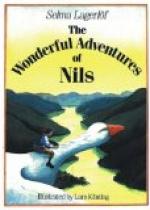At once the boy saw the whole school before him. The children sat by the little desks and raised their hands; the teacher sat in the lectern and looked displeased; and he himself stood before the map and should answer some question about Blekinge, but he hadn’t a word to say. The schoolmaster’s face grew darker and darker for every second that passed, and the boy thought the teacher was more particular that they should know their geography, than anything else. Now he came down from the lectern, took the pointer from the boy, and sent him back to his seat. “This won’t end well,” the boy thought then.
But the schoolmaster had gone over to a window, and had stood there for a moment and looked out, and then he had whistled to himself once. Then he had gone up into the lectern and said that he would tell them something about Blekinge. And that which he then talked about had been so amusing that the boy had listened. When he only stopped and thought for a moment, he remembered every word.
“Smaland is a tall house with spruce trees on the roof,” said the teacher, “and leading up to it is a broad stairway with three big steps; and this stairway is called Blekinge. It is a stairway that is well constructed. It stretches forty-two miles along the frontage of Smaland house, and anyone who wishes to go all the way down to the East sea, by way of the stairs, has twenty-four miles to wander.
“A good long time must have elapsed since the stairway was built. Both days and years have gone by since the steps were hewn from gray stones and laid down—evenly and smoothly—for a convenient track between Smaland and the East sea.
“Since the stairway is so old, one can, of course, understand that it doesn’t look just the same now, as it did when it was new. I don’t know how much they troubled themselves about such matters at that time; but big as it was, no broom could have kept it clean. After a couple of years, moss and lichen began to grow on it. In the autumn dry leaves and dry grass blew down over it; and in the spring it was piled up with falling stones and gravel. And as all these things were left there to mould, they finally gathered so much soil on the steps that not only herbs and grass, but even bushes and trees could take root there.
“But, at the same time, a great disparity has arisen between the three steps. The topmost step, which lies nearest Smaland, is mostly covered with poor soil and small stones, and no trees except birches and bird-cherry and spruce—which can stand the cold on the heights, and are satisfied with little—can thrive up there. One understands best how poor and dry it is there, when one sees how small the field-plots are, that are ploughed up from the forest lands; and how many little cabins the people build for themselves; and how far it is between the churches. But on the middle step there is better soil, and it does not lie bound down under such severe cold, either.




